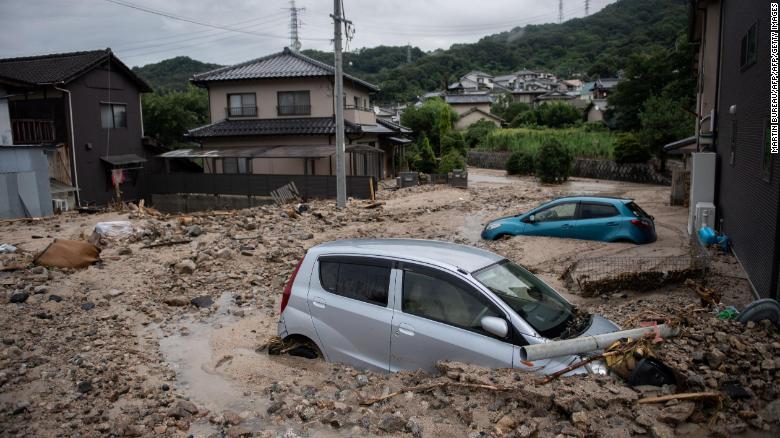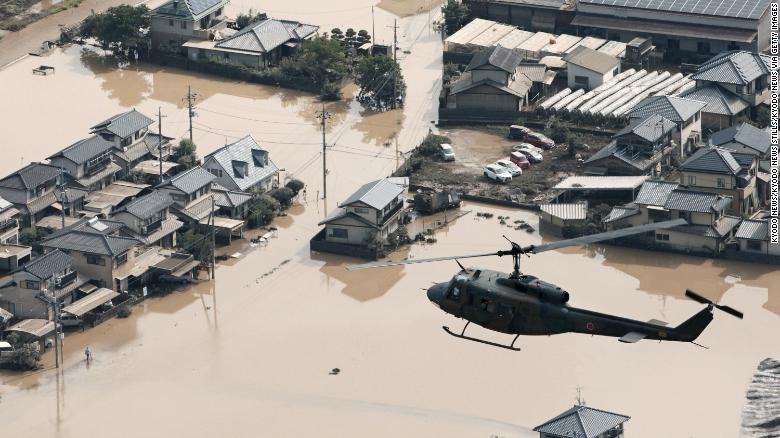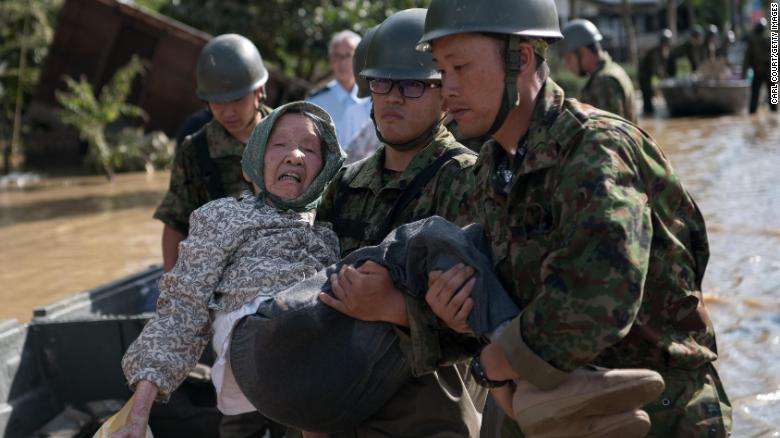https://edition.cnn.com/2018/07/10/asia/japan-floods-intl/index.html
Japan floods: Death toll rises to 176 as Abe visits affected areas

More than 100 dead as heavy rain pounds Japan 01:23
Tokyo (CNN)Landslides and flooding caused by torrential rain in Japan have killed another 21 people in what has become one of the deadliest natural disasters to hit the country since the earthquake and tsunami at Fukushima in 2011.
A total of 176 people have been killed since the downpour began late last week, Japanese Chief Cabinet Secretary Yoshihide Suga said Wednesday. Another nine are missing.
Some 75,000 responders have been deployed to the area for search and rescue operations. Suga warned that thunderstorms and landslides in the coming hours could pose further danger.
Japanese Prime Minister Shinzo Abe was in Okayama Prefecture Wednesday morning surveying the damage in one of the hardest-hit areas. He canceled a scheduled trip to Europe and the Mideast to focus on disaster relief efforts.
Abe viewed the damage from above in a helicopter, viewing what he called the "scars of the terrible damage of heavy rain" and visited an evacuation center.
He said the government had been making "every effort to deal with this crisis since the disaster occurred."
Tokyo (CNN)Landslides and flooding caused by torrential rain in Japan have killed another 21 people in what has become one of the deadliest natural disasters to hit the country since the earthquake and tsunami at Fukushima in 2011.
A total of 176 people have been killed since the downpour began late last week, Japanese Chief Cabinet Secretary Yoshihide Suga said Wednesday. Another nine are missing.
Some 75,000 responders have been deployed to the area for search and rescue operations. Suga warned that thunderstorms and landslides in the coming hours could pose further danger.
Japanese Prime Minister Shinzo Abe was in Okayama Prefecture Wednesday morning surveying the damage in one of the hardest-hit areas. He canceled a scheduled trip to Europe and the Mideast to focus on disaster relief efforts.
Abe viewed the damage from above in a helicopter, viewing what he called the "scars of the terrible damage of heavy rain" and visited an evacuation center.
He said the government had been making "every effort to deal with this crisis since the disaster occurred."
Abe then visited the devastated city of Kurashiki and met with the governor of Okayama.

A residential area is seen on July 9 in Kurashiki, Okayama Prefecture, submerged following torrential rains that hit a wide area of western Japan.
The rain started to pour on Thursday and picked up Friday. Over the weekend, parts of Japan received between 300 to 500 millimeters (12 to 20 inches) of rain, with prefectures of Hiroshima, Okayama, and Hyogo inundated with more than 500 millimeters.
Some cities were completely inundated in a matter of hours.
Japanese public broadcaster NHK reported about 364 millimeters (14.3 inches) of rain fell between 5 a.m. and 7 a.m. Sunday in Uwajima -- approximately 1.5 times the average monthly rainfall for July.
In Sukumo City in Kochi prefecture, 263 millimeters (10.3 inches) of rain fell in two hours, NHK said.
The flooding was particularly harsh because much of the rain fell over a mountainous region and then funneled down, causing heavy flash flooding.
Hundreds of thousands of people were forced to flee their homes, and those unable to leave took shelter on rooftops as the streets filled with water.

Soldiers carry an elderly woman away from flood water on July 8, 2018 in Kurashiki near Okayama, Japan.
Japan is no stranger to natural disasters, especially earthquakes. A series of quakes in Kumamoto in 2016 led to the deaths of more than 200 people, according to the Japanese Red Cross Society.
More than 20,000 people were killed or went missing during the Fukushima disaster, when a 9.0-magnitude earthquake hit Japan, triggering a tsunami and nuclear meltdown at the Fukushima nuclear plant.
CNN's Michael GUy and Jessie Yeung contributed to this report
沒有留言:
張貼留言